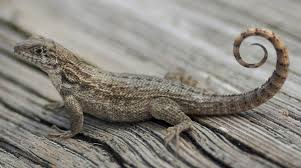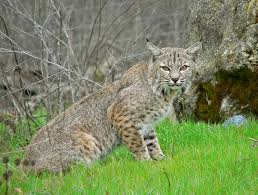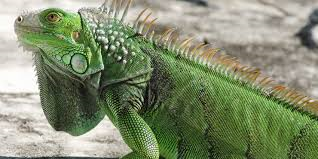Predators of Marco

Marco Island has a beautiful yet fragile ecosystem that can be affected easily by invasive species, such as the curly-tailed lizard and the green iguana. While some animals can be a danger to Marco Island’s ecosystem, some can be a danger to your family and pets, as well.
Curly-Tailed Lizards
 The Leiocephalus Chordatacurly, also known as the curly-tailed lizard, is becoming a very common sight on Marco Island. The lizard can grow anywhere from three to seven inches. Native to the Bahamas and Cayman Islands, its population is thriving here on Marco. According to www.wildflorida.com, the curly-tailed lizard was “first introduced to Florida in the 1940’s to combat sugarcane pests”. However, due to a lack of natural predators, and being well suited to their new environment of Marco Island, the curly-tail lizard has become a nuisance.
The Leiocephalus Chordatacurly, also known as the curly-tailed lizard, is becoming a very common sight on Marco Island. The lizard can grow anywhere from three to seven inches. Native to the Bahamas and Cayman Islands, its population is thriving here on Marco. According to www.wildflorida.com, the curly-tailed lizard was “first introduced to Florida in the 1940’s to combat sugarcane pests”. However, due to a lack of natural predators, and being well suited to their new environment of Marco Island, the curly-tail lizard has become a nuisance.
Their level of frequency has become very concerning, due to the curly-tail outcompeting native species such as the green anole for resources and consuming them. Being an omnivorous creature, the curly-tailed lizard eats seemingly everything in its path, including seeds, flowers, and bugs. Gerard Miller, the Environmental Science teacher at Marco Island Academy stated that he “constantly sees the lizards, and frequently sees healthy adolescent ones as well, suggesting the population will continue to grow. He said, “There’s not much we can do about curly tails, so we have to learn to live with them. Non-native species are often dangerous to their introduced environment because they lack natural predators and throw off the balance that once was, which is why we need to protect our ecosystems.” Continuing, Mr. Miller said, “The biggest takeaway is that we have to be way more careful about what species, if any, we introduce in the future.”
Bobcats
Oftentime s mistaken for a Florida Panther, the Bobcat (Felis rufus) population on Marco Island is rather healthy. Bobcats can be distinguished from panthers by their spots and longer hair. They also weigh over 100 pounds less than Florida Panthers, and are only the size of two average house cats. Bobcats are native to the island, but their population has been on the decline since people started to build there. Bobcats typically hunt small rodents, but can be a problem when they kill family pets such as cats or smaller dogs. Even the largest of Bobcats are not as dangerous as the average Florida Panther, due to their significantly smaller size and targeting of small prey.
s mistaken for a Florida Panther, the Bobcat (Felis rufus) population on Marco Island is rather healthy. Bobcats can be distinguished from panthers by their spots and longer hair. They also weigh over 100 pounds less than Florida Panthers, and are only the size of two average house cats. Bobcats are native to the island, but their population has been on the decline since people started to build there. Bobcats typically hunt small rodents, but can be a problem when they kill family pets such as cats or smaller dogs. Even the largest of Bobcats are not as dangerous as the average Florida Panther, due to their significantly smaller size and targeting of small prey.
Iguanas
Iguanas used to be a n uisance to people on Marco Island until the city issued a contract with Iguana Control, Inc. to help control the population in 2008. Often released as unwanted pets, the iguana population can grow exponentially in Florida due to the hot climate and abundant food source. They can lay anywhere between 10 and 70 eggs per year but only one in 300 eggs reach maturity, and reproduce, themselves. On Marco Island, the lizards barely have any predators and eat many different insects, vegetation, and animal eggs. Iguanas can damage the island by eating plants in homeowner’s yards, destroying foundations, and even hurting locals when they feel threatened (though usually they just run away). Female iguanas can destroy homes by digging burrows for their nests, while males can defecate on their basking grounds. “I rarely see iguanas anymore”, inquires Mr. Miller, feeling lucky that the iguana population on Marco has dropped significantly with only a few sightings a month from the city of Marco Island.
uisance to people on Marco Island until the city issued a contract with Iguana Control, Inc. to help control the population in 2008. Often released as unwanted pets, the iguana population can grow exponentially in Florida due to the hot climate and abundant food source. They can lay anywhere between 10 and 70 eggs per year but only one in 300 eggs reach maturity, and reproduce, themselves. On Marco Island, the lizards barely have any predators and eat many different insects, vegetation, and animal eggs. Iguanas can damage the island by eating plants in homeowner’s yards, destroying foundations, and even hurting locals when they feel threatened (though usually they just run away). Female iguanas can destroy homes by digging burrows for their nests, while males can defecate on their basking grounds. “I rarely see iguanas anymore”, inquires Mr. Miller, feeling lucky that the iguana population on Marco has dropped significantly with only a few sightings a month from the city of Marco Island.
Your donation will help support not only the student Journalism and Yearbook clubs at Marco Island Academy, but as well as any new equipment, club improvements, and annual website hosting costs.

Aidan Libby is a 14 year old freshman at Marco Island Academy, working as a Staff Writer for the MIA newspaper, The Wave. Other than being a student, Aidan...



Stacy • Apr 18, 2020 at 4:25 PM
Thank you for this information, Aiden! Exactly what I was searching for
Ryan Sullivan • Dec 16, 2017 at 5:14 PM
This was a really interesting article, I’ll be sure to recommend it to others.
sofiA saaVEdrA • Dec 14, 2017 at 10:07 AM
Good job Aidan!!! You did it!!!